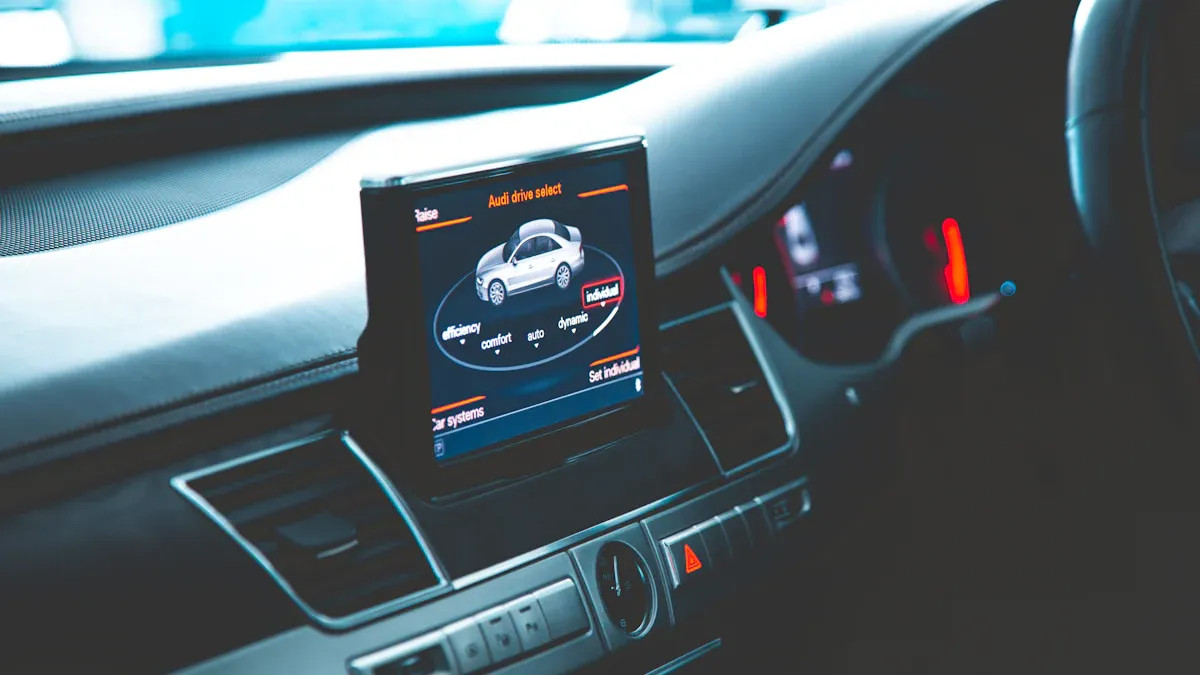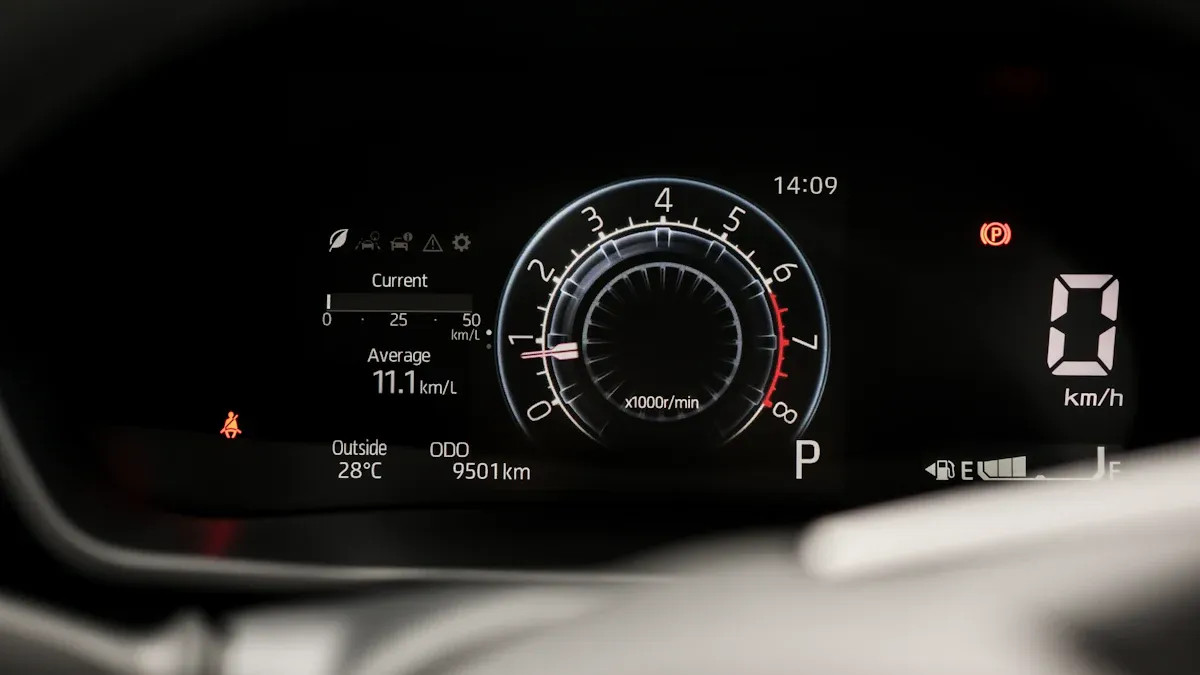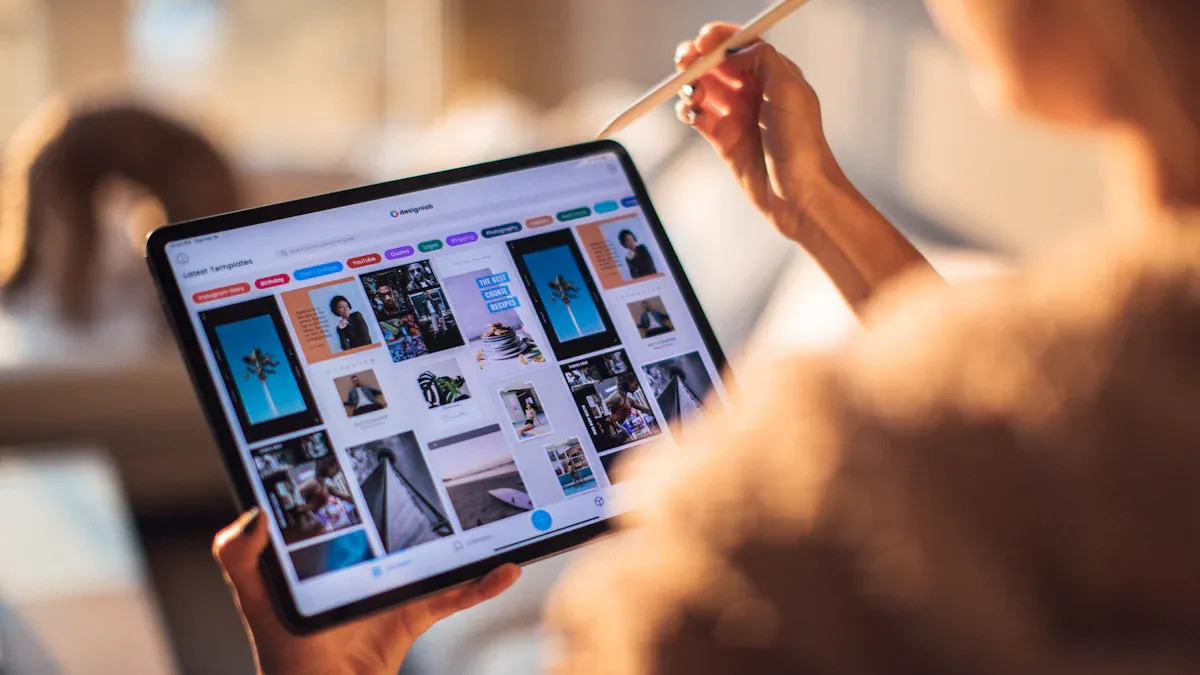search
What Are You Looking For?

TFT LCD displays are used in many car dashboards and home devices. The main panel types are TN, IPS, VA, and LTPS. People like tft lcd technology because it looks sharp and works fast. It can also be changed to fit different needs. In cars, this technology gives clear pictures and works well. Smart home devices use tft lcd panels for easy and quick controls. Each display type has special features for different smart and car uses.
TFT LCD displays show clear pictures and react fast. This makes them great for cars and smart home devices.
Panel types like TN, IPS, VA, and LTPS each have special strengths. These include speed, color, contrast, and saving energy.
Cars use TFT LCDs in dashboards, screens, mirrors, and control panels. These displays help make driving safer and more comfortable.
Smart home devices use TFT LCDs in thermostats, lights, appliances, and hubs. This helps people control things easily and see information clearly.
Picking the best display means looking at size, brightness, strength, and power use. The display should match the device and where it will be used.
A tft lcd is a kind of flat screen. It uses thin-film transistor technology to control each pixel. Each pixel has its own transistor. This helps the display show pictures fast and clear. You can find tft lcd screens in car dashboards and smart home panels. They are also in many other devices.
The tft part means "thin-film transistor." This technology lets the lcd screen control colors and brightness better. The lcd part stands for "liquid crystal display." Liquid crystals change how light moves through the screen. This makes the pictures and words you see. When tft and lcd work together, the display is good for many things.
Note: Engineers pick tft lcd panels because they show sharp images and respond fast. These things are important in cars and smart home devices. People need clear information right away.
Tft lcd displays have many good points. These make them a top choice for cars and smart homes.
Clarity: The display shows sharp pictures and bright colors. Drivers and homeowners can read things easily.
Fast Response: The tft technology lets the screen change fast. This helps when people need updates right away.
Customization: Makers can build tft lcd screens in many shapes and sizes. They fit dashboards, control panels, or small appliances.
Energy Efficiency: The lcd uses less power than old screens. Devices can last longer without charging or new batteries.
Wide Use: Tft lcd displays work in many places. They handle heat, cold, and sunlight better than some other screens.
|
Feature |
Benefit for Users |
|---|---|
|
Sharp Images |
Easy to read information |
|
Fast Updates |
Real-time feedback |
|
Custom Shapes |
Fits many devices |
|
Low Power Use |
Longer battery life |
Tft lcd displays help make cars and smart homes smarter and easier to use.
Manufacturers use three main types of TFT panels. These are found in cars and smart lcd displays. The types are TN, IPS, and VA. Each one has special features for different uses.
TN (Twisted Nematic):
TN panels change fast. Car dashboards often use TN because drivers need quick updates. TN panels cost less than other types. The colors and viewing angles are not as good as others. But they work well in simple smart lcd displays.
IPS (In-Plane Switching):
IPS panels show bright colors and wide viewing angles. Smart home devices often use IPS. People can see the display from many places in a room. IPS panels help users read information clearly, even in bright light.
VA (Vertical Alignment):
VA panels balance color and contrast. Some car systems use VA for deep blacks and clear images. VA panels work well in displays that need good color and strong contrast.
Tip: Think about where people will use the display. TN is best for speed. IPS is best for color. VA is best for contrast.
Some smart lcd displays use advanced panel types. LTPS and AMOLED alternatives have new features for cars and smart devices.
LTPS:
LTPS panels show higher resolution and use less power. Many car displays use LTPS for sharp images and long battery life. LTPS helps smart lcd displays show more details in small spaces.
AMOLED Alternatives:
AMOLED panels use organic materials to make light. These panels show deep blacks and bright colors. Some smart lcd displays use AMOLED alternatives for better color and thinner screens. But AMOLED can cost more and may not last as long as tft lcd panels.
|
Panel Type |
Best For |
Key Benefit |
|---|---|---|
|
LTPS |
Automotive, Smart |
High resolution |
|
AMOLED |
Smart Devices |
Vivid colors |
Touchscreens are common in cars and smart lcd displays. These screens let users control devices with a tap or swipe. Touchscreen technology makes smart home panels easy to use. In cars, touchscreens help drivers and passengers change settings quickly.
Capacitive Touch:
Most smart lcd displays use capacitive touch. This type works with light finger taps. It is good for home panels and car infotainment systems.
Resistive Touch:
Some car displays use resistive touch. This type works with gloves or styluses. It helps in places where people need to wear gloves, like cold weather.
Note: Touchscreen displays make controls simple and direct for users.
Manufacturers now make custom and flexible tft lcd panels. These panels fit special shapes and spaces in cars and smart lcd displays.
Custom Panels:
Custom tft lcd panels match the size and shape of dashboards or smart home devices. Makers design these displays to fit tight spaces or curved surfaces.
Flexible Panels:
Flexible tft lcd panels bend without breaking. Some car displays use flexible panels for curved dashboards. Smart lcd displays in home devices can also use flexible panels for modern designs.
Custom and flexible panels help designers make smart products that stand out. These displays support new ideas in cars and homes.

Automotive tft display systems have made cars easier to use. These systems use tft technology to show clear information to everyone in the car. The displays are used in many parts of the vehicle. Each use helps make driving safer and more comfortable.
The dashboard is where drivers see important information. Instrument clusters use tft displays to show speed, fuel, and warnings. These displays have sharp images that are easy to read. The tft panels react quickly, so drivers see updates fast. Many car companies pick tft displays because they work in bright sun and at night. The display can also change colors or layouts for different driving modes.
Note: A clear dashboard helps drivers pay attention and stay safe.
Infotainment systems use tft displays for maps, music, and settings. Passengers use these screens to control sound or watch videos. Headrest monitors use tft panels to entertain people in the back seats. The automotive tft display system lets users tap or swipe to pick options. These displays must show bright colors and work from many angles. The tft technology keeps images smooth and clear, even when the car moves.
|
Feature |
Benefit for Users |
|---|---|
|
Touch Controls |
Easy to use |
|
Wide Viewing |
Good for all passengers |
|
Fast Response |
No waiting for updates |
Some cars use tft displays in mirrors and on the roof. Rearview mirrors with tft panels show camera views behind the car. This helps drivers park and avoid hitting things. Roof-mounted displays give information or entertainment to everyone in the car. These displays must work in different light and temperature conditions. The tft panels here are thin and light, so they fit in small spaces.
Tip: Mirror and roof displays help make cars safer and more comfortable.
Control panels in cars use tft displays for things like air conditioning and seat position. Climate systems show temperature and airflow on small tft screens. These displays let users change settings with a touch or button. The automotive tft display system connects with other smart features in the car. Fast response and clear images help users make changes without losing focus.
Automotive uses for tft displays keep growing. Car makers use these displays to connect drivers with smart systems and new features. The right display gives clear, fast, and reliable information in every part of the car.

Smart lcd displays are now found in many smart homes. These screens help people control devices and do tasks. They also let users interact with their home. You can see these screens in thermostats and lighting panels. They are also in appliances and home automation hubs. Each use of lcd technology helps make life easier and saves time.
Thermostats with smart lcd displays show temperature settings clearly. Many smart thermostats have Wi-Fi. This lets people change the temperature from their phones. Voice control works with Alexa or Google Assistant. The display shows temperature, humidity, and energy use. Some systems use geofencing to change settings when people leave or come home. Energy-saving features like scheduling and tracking help lower bills. These displays make it easy to control your smart home.
Wi-Fi lets you control from far away
Works with voice assistants
Easy-to-read lcd screen
Tracks energy and lets you schedule
Shows humidity and uses geofencing
Smart lcd displays in lighting and security panels help manage lights and alarms. The screen shows which lights are on. People can set timers or scenes. Security panels use lcd screens to show alerts and camera views. They also show system status. Touch controls make it easy to arm or turn off systems. These screens give fast updates and clear pictures, even in dim light.
Many smart appliances now have lcd displays. Refrigerators, ovens, and washing machines use these screens. They show settings, timers, and alerts. The display helps users pick modes and check progress. It also gives reminders and tips to save energy. These screens make home chores easier and more fun.
|
Appliance |
Display Use |
|---|---|
|
Refrigerator |
Shows temperature, reminders |
|
Oven |
Cooking modes, timers |
|
Washing Machine |
Cycle status, alerts |
Home automation hubs use smart lcd displays as the main control spot. The screen shows device status, schedules, and alerts. Users can tap the screen to control lights and locks. They can also control other devices. These hubs connect with many smart apps and help run the whole system. The lcd display is a simple and cheap way to control smart tech in one place.
Tip: A good screen makes smart home devices easier and more reliable.
The size and resolution are important for every display. Car dashboards need screens that fit and show numbers clearly. Smart home panels come in different sizes for each room. Bigger screens let people see more at once. High resolution makes words and pictures look sharp. People should look at the display’s details before buying. The data sheet tells the size and number of pixels. This helps people pick the right display for what they need.
Tip: Always check the data sheet to compare size and resolution.
Brightness helps people see the screen in sunlight or at night. Car screens need to be very bright for outside use. Smart home screens work best if you can change the brightness. Viewing angles tell how far to the side you can see the screen well. IPS panels have wide viewing angles. The display’s details will show these numbers. LED backlights also help make screens brighter. A good screen meets both brightness and led backlight needs.
|
Factor |
Car Use |
Smart Home Use |
|---|---|---|
|
Brightness |
High needed |
Adjustable needed |
|
Viewing Angle |
Wide needed |
Wide needed |
Durability means the screen keeps working in hard places. Cars get hot, cold, and bumpy. Smart home screens might get dust or wet. The display’s details should show the voltage and temperature it can handle. A strong screen lasts longer and breaks less. The data sheet gives facts about how tough the screen is.
Power use is important for cars and smart homes. The power supply tells how much energy the screen needs. Low-power screens help batteries last longer. The voltage must match the system. Smart devices need screens that connect with other things. The video signal shows how the screen connects to cameras or computers. Good integration means the screen works with smart features and updates easily.
Note: Always check the display’s details for power and integration before buying.
TFT LCD displays come in many types like TN, IPS, VA, and LTPS. They help drivers and homeowners see clear information fast. People should check size, brightness, and power needs before choosing a display. Each environment needs a different screen.
Experts expect new TFT LCD technology to bring even brighter, more flexible, and energy-saving screens to cars and smart homes soon.
TFT LCD displays show clear images and respond quickly. Drivers see important information right away. These screens work well in sunlight and last longer than older types.
Not every panel fits every device. Smart home devices often use IPS or LTPS panels. These types give wide viewing angles and bright colors. The choice depends on the device’s needs.
Manufacturers use special touch technology. Capacitive touch works well for most users. Resistive touch lets people use gloves. Both types keep controls accurate in hot or cold weather.
TFT LCD displays use less power than older screens. LTPS panels save even more energy. This helps car batteries last longer and keeps smart home devices running without frequent charging.
Brightness depends on the panel type and backlight. IPS and LTPS panels often look brighter. LED backlights help displays stay clear in sunlight. The right panel makes information easy to see at any time.
Copyright © 2017 Guangdong Shengfeng Technology Co., Ltd. All Rights Reserved.Sitemap | Blog | Xml | Privacy Policy  Network Supported
Network Supported